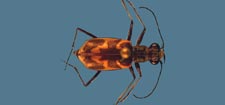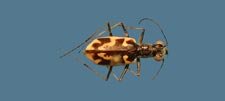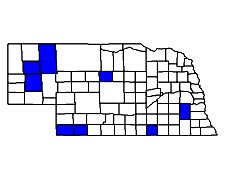
| Cicindela nevadica LeConte |
| Adult Length: 10 to 14 mm |
| Appearance: Cicindela nevadica knausi Leng Adults are olive green to bronze with a moderate amount of maculation on the dorsal surface. The posthumeral mark extends at an angle toward the posterior and is normally only slightly upturned at the end. The middle band is complete and connected to a marginal band that connects all lunules. Cicindela nevadica lincolniana Casey Adults are dark greenish to dark brown or even blackish with a variable amount of maculation on the dorsal surface. Most individuals have very reduced markings, but a few may have markings similar to ssp. knausii. This subspecies differs from ssp. knausii in the generally reduced markings and that the dorsal colors are darker and glossier. Some authors suggest it may be a distinct species. |
| Similar Species: Cicindela nevadica knausii or heavily marked individuals of C. nevadica lincolniana could be confused with C. macra or C. cuprascens, but the middle band is usually not reticulated and does not extend toward the suture above the foot in most cases. In addition, the humeral mark is not expanded into a triangular shape as it is in those two species. Cicindela nevadica lincolniana is not likely to be confused with any other species. |
| Biology: This species occurs in moist to wet saline environments with sparse vegetation such as along saline ponds, creeks, and ditches. Cicindela nevadica lincolniana is restricted to wet saline creek banks in the vicinity of Lincoln, Nebraska. |
| Adult Life History: Adults emerge from the pupa in late spring and early summer. The two subspecies differ somewhat in adult seasonality. Adults of C. nevadica lincolniana are active mostly from late May to mid-July, with peak numbers in June. Adults of C. nevadica knausii are active mostly from mid-June to early August with peak numbers in July. Adults of both subspecies are rare by late August. Adults are attracted to lights at night. It is a summer species. |
| Larval Life History: Eggs are laid in summer and most larvae probably reach the second instar by fall before overwintering. The third instar is presumably reached the following summer, with pupation and adult emergence the summer thereafter for a total larval life cycle of most likely two years. Larvae develop in moist to wet saline soil along the edge of vegetation or on muddy saline banks. |
| Biogeography: This species has been recorded from eight Nebraska counties. Its distribution appears to be somewhat patchy with the east-central panhandle as a population center. All county records are for ssp. knausii except for the records for Lancaster County, which are ssp. lincolniana. Cicindela nevadica knausii should be expected anywhere in the state wherever suitable habitat occurs, but C. nevadica lincolniana is limited to remnant saline patches in and around Lincoln Nebraska. Habitat loss and nocturnal light pollution threaten the continued existence of this unique insect. In North America it occurs in scattered locations from southern Texas and eastern Arizona to northwestern Texas, Oklahoma, Kansas, Colorado, Nebraska, Wyoming, North and South Dakota, eastern Montana, and southernmost Manitoba, Saskatchewan and Alberta. Separate populations occur from southern California to northern Nevada. Six subspecies have been described, and at least two more unique populations may prove to be unique subspecies. |



